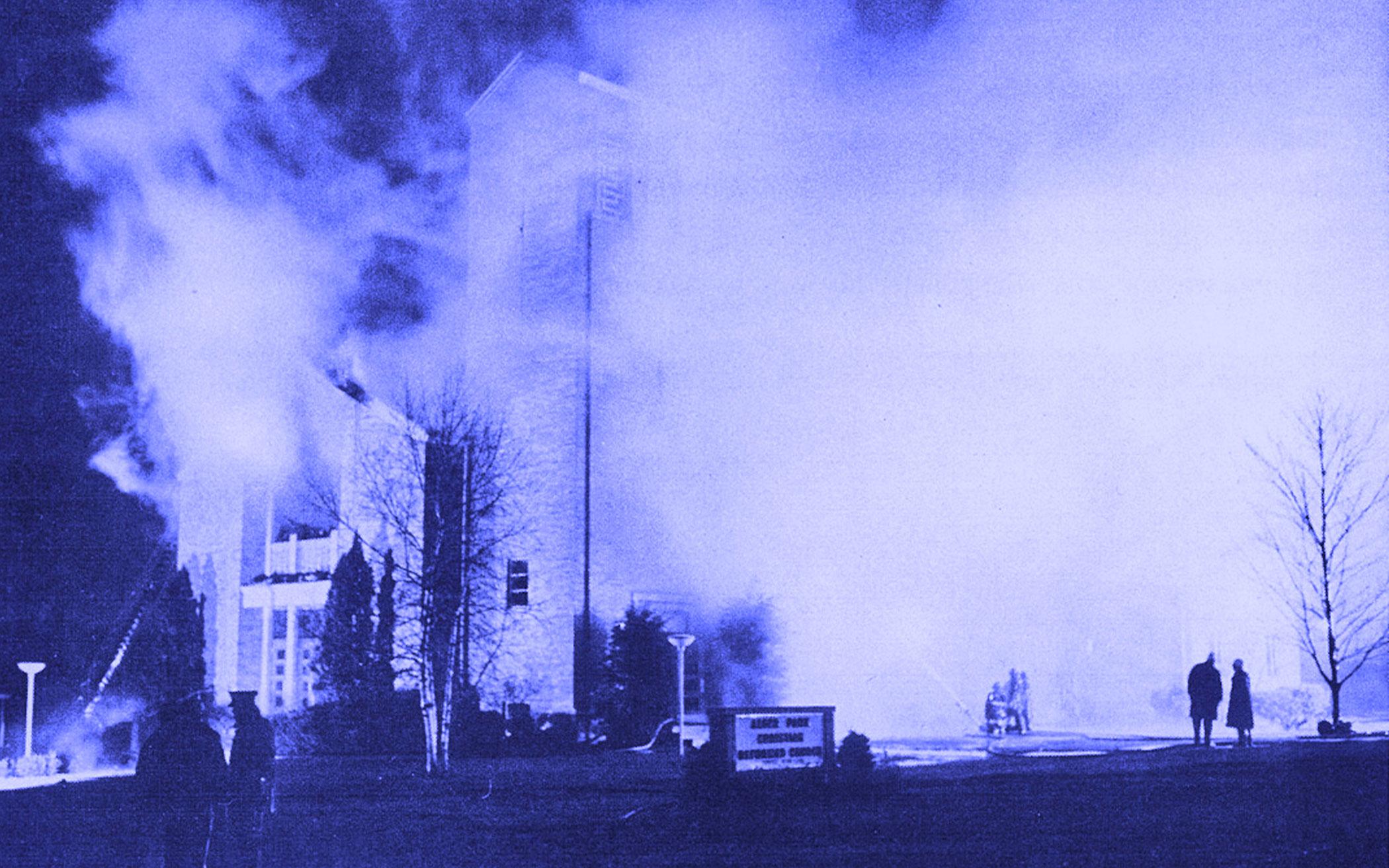On Christmas night, 1971, Alger Park Church caught on fire.
A single light bulb illuminating a stained-glass window was left on after the Christmas service. Sometime late in the night, the overheated bulb fell onto a pew and ignited the fabric. The fire quickly spread. Soon the stained-glass windows collapsed and melted. Smoke billowed from the bell tower, and flames consumed the choir loft. Neighbors stepped outside their doors into the cold December night to watch the unfolding tragedy in stunned silence.
The fire department quickly responded. They sprayed thousands of gallons of water into the church in an attempt to douse the flames and save the sanctuary. A few courageous firefighters split off toward the back of the building and found their way to the pastor’s office. In an attempt to save a lifetime’s worth of collected commentaries and other resources, they tossed hundreds of books through a window onto a tarp on the frostbitten ground.
As the fire continued to blaze fiercely, more and more water poured into the sanctuary. Soon there was so much water covering the floor that the baptismal font rose from its position and floated down the center aisle. From there the swirling waters carried the font down two flights of stairs, through the opening where the doors had been beaten down, and into the parking lot. As light dawned the following morning and members huddled together to survey the stunning loss, they found the flame-licked baptismal font far from the sanctuary, tipped toward the adjacent street.
This past Christmas marked the 50th anniversary of that night.
In the church archives are pictures and unique details from eyewitnesses, some of whom still attend Alger Park Church. Archived documents say that within a few months, the roof was rebuilt, windows had been replaced, and almost all traces of fire damage were erased. But if you go into the church’s attic spaces you can still find a few charred bricks near the apex of the sanctuary roof.
In addition to a few hidden bricks, charred memories lingered in the hearts and minds of some who were there. Years after the fire, someone from the congregation painted the fiery scene. The painting was hung with a bronze plaque telling a moralizing tale about the fleeting nature of all things material.
When I first saw the painting and heard the stories, I interpreted the fire as a tragic event overcome by a group of hardworking people. But as I reflect on the story again, on the 50th anniversary of that night, I think the most important part of the story was the fire-licked baptismal font in the parking lot.
The sacrament of baptism is a means of grace. It’s about who God is and how God relates with us. The flowing water is a tangible expression and experience of God’s grace. God is love, and we are the recipients of God’s love. But love doesn’t stop there. The biblical story goes on to assert and demonstrate that there is an outflowing nature to love. As it turns out, baptismal waters are never meant to stay in the sanctuary. They are meant to flow out into the surrounding community.
In some churches the baptismal water rests in a bowl. But traditionally baptismal waters are supposed to be flowing. Many branches of the church carry on this tradition with a bubbling font near the church’s front entrance. Many other churches prefer to baptize folks in the moving water of a river, lake, or ocean.
Jesus was baptized in flowing waters. As the Jordan River moved around him, over him, and under him, he was named God’s beloved—just as we are when we receive the sacrament. Jesus’ ministry embodied the flowing nature of his baptism when his identity was lived out through his words and actions. His life overflowed and touched the marginalized people on the outskirts of society. Jesus understood that God’s blessing is not static. It blesses in order to let others know that they are blessed too. It flows out in order to draw in. When we receive the sacrament of baptism, do we embody the flowing nature of God’s grace in the same way Jesus did?
On Christmas night in 1971, the baptismal font floated down the stairs and into the parking lot. Baptismal waters are flowing waters, and God’s grace is always trying to escape the confines of the church walls, out through the doors to drench our community in endless waves of blessing. And when the water becomes static, fire gets the water flowing again.
This is not new. Listen to Jesus as he addressed his disciples in Acts 1:8: “But you will receive power when the Holy Spirit comes on you; and you will be my witnesses in Jerusalem, and in all Judea and Samaria, and to the ends of the earth.” When a flame appeared on Peter’s head, Peter stood up to preach his first sermon. Listen to what he said to those who were gathered: “The promise is for you and your children and for all who are far off—for all whom the Lord our God will call” (Acts 2:39).
As it turns out, fire pushed the promise out into the neighborhood.
Baptismal water is flowing water because the blessing is meant to drench and then move outward toward others. It flows out in order to draw in. This is why at the end of every worship service, the congregation is sent in the power of the Spirit as a blessed people, a loved people, a baptized people, into the parking lot tilting toward the neighborhood.
It was true 2,000 years ago.
It was true in 1971.
It’s still true today.
Editor’s Note: A version of this article was first published on the Alger Park website, algerparkchurch.org/blog/archives/08-2020.
About the Author
Sam Gutierrez is the Associate Director at the Eugene Peterson Center for the Christian Imagination at Western Theological Seminary. More of his creative work can be found at printandpoem.com







